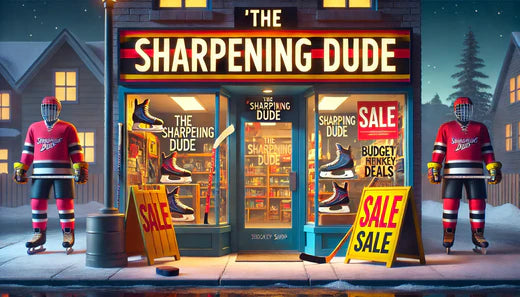
The Sharpening Dude's Hockey 101 | Budget Tips
Share
Hockey 101: Budget Tips
Hockey is an incredible sport that builds character, discipline, and teamwork. However, one of the most significant challenges for families is the cost associated with playing. While youth sports in general require a financial commitment, hockey can be a bit more demanding. The good news? There are plenty of ways to reduce costs without compromising your child's experience on the ice. With some thoughtful planning and smart decision-making, you can keep hockey accessible and enjoyable for your family.
Here are our top tips for managing hockey costs:
1. Take Advantage of Used Equipment
Leasing or purchasing used equipment can save you a significant amount of money. Many local hockey associations offer equipment for younger players at low or no cost. Additionally, sporting goods stores often carry gently used gear for older players. Just make sure to prioritize safety, fit, and comfort—especially when it comes to helmets and skates. Investing in properly fitted equipment ensures your child stays safe and performs their best.
2. The Equipment Doesn’t Make the Player
If used equipment isn’t your preference, consider shopping for new gear at a lower price point. Many manufacturers produce equipment across various quality levels, meaning you can find affordable options without sacrificing functionality. For younger players, the difference in performance between high-end and entry-level gear is often negligible. Items like wooden sticks, for example, can be a budget-friendly alternative that still gets the job done.
3. Volunteer!
Time is money, and this is especially true in community-based hockey programs. Volunteering with your local association can help reduce registration fees while supporting the sport you love. Many associations rely on parent volunteers to keep costs low, so your time and effort directly contribute to making hockey more affordable for everyone.
4. The Power of “No”
It’s tough to say no to your kids, but sometimes it’s the right choice. Extra tournaments, summer travel leagues, and top-of-the-line gear aren’t always necessary. Setting boundaries on what you spend can teach valuable life lessons about budgeting and priorities. Plus, kids often appreciate their experiences and equipment more when they understand the effort it takes to provide them.
5. Cut Down on Impulse Buying
Spending long hours at the rink can lead to impulsive purchases, especially on food and drinks. Planning ahead with healthy snacks and well-timed meals at home can significantly cut down on concession stand visits. Over the course of a season, these small savings add up.
6. A Season of Giving
If your child has their heart set on a high-end stick or a new pair of skates, consider making it a holiday or birthday gift. This approach helps integrate the expense into your existing gift budget, making it more manageable. Plus, it’s a thoughtful way to give them something they’ll truly value.
7. Comparison Shop
The internet is your best friend when it comes to finding deals. Use it to compare prices across different retailers and brands. Many stores also post information about upcoming sales and promotions, so you can plan your purchases to coincide with discounts.
8. Be a Smart Shopper
Like any industry, hockey retail has its seasonal sales. The best time to find deals is typically at the end of the season (March or April), when retailers clear out inventory to make room for new gear. Keep in mind, though, that kids grow quickly. If you buy ahead, consider sizing up or waiting to cut sticks until the start of the next season.
Final Thoughts
Hockey may require a larger financial investment than some other sports, but with strategic planning, you can make it affordable for your family. By prioritizing needs over wants, seeking out deals, and volunteering your time, you can keep costs in check while ensuring your child has the opportunity to enjoy and excel in the game.
At The Sharpening Dude, we’re here to support your hockey journey. Whether it’s providing expert skate sharpening or helping you find affordable gear, we’re committed to making hockey accessible for everyone.
